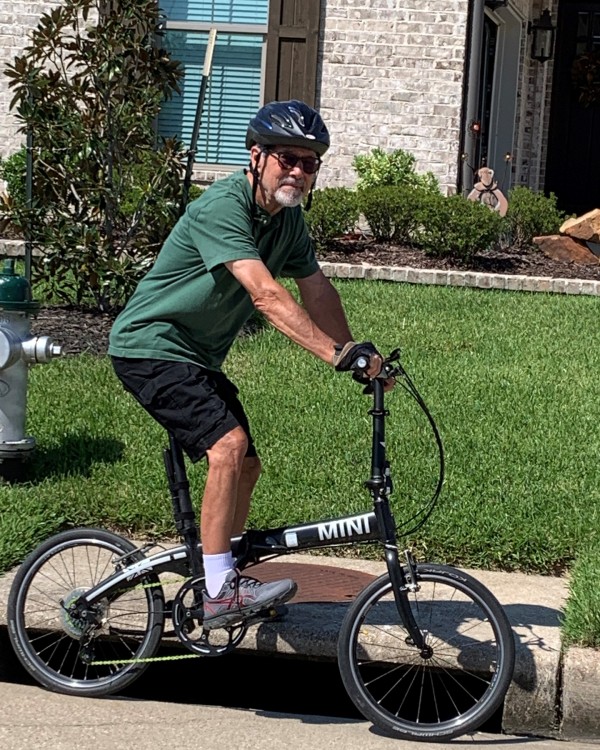
“It wasn’t painful. It wasn’t really even uncomfortable. It was just really weird,” he recalls. “I analogize it to what it feels like when you’re in an elevator and the elevator changes directions, and your stomach ends up in your throat.”
He’d felt a similar sensation before, but usually just for a minute or two. This time it persisted. He happened to have a pulse oximeter nearby, and he put it on his finger while he was still seated. His heart rate kept rising: 150, 160, 170. He called to his wife in the other room. “I’m feeling really strange,” he told her.
He didn’t think it was a heart attack. If so, he figured, he’d be doubled over in pain. But he knew something was wrong. He also knew he had a family history of heart issues: his father had had a stroke in his late 70s, leaving him with right side paralysis and incapable of speech until he passed away at 87.
Provost, now 79, feared he was also at risk of stroke. His wife drove him to the nearest emergency center, where an electrocardiogram confirmed that it was not a heart attack, but it was something out of the ordinary. “They said, ‘You definitely have an issue, and it looks like it’s AFib,’ ” he recalls.
AFib, short for atrial fibrillation, is an abnormal heartbeat that happens when the upper chambers of the heart contract irregularly,causing blood to pool and clot in the left atrial appendage of the heart, which can lead to a stroke. The condition causes about one out of every seven strokes, according to the Centers for Disease Control and Prevention. And strokes caused by AFib tend to be more severe than strokes with other underlying causes.
After visiting his primary care doctor, Provost was referred to Dr. Khashayar Hematpour, a cardiac electrophysiologist affiliated with Larry D. Johnson Heart & Vascular Institute at Memorial Hermann-Texas Medical Center. Provost’s case was somewhat unusual because, apart from AFib, he was in perfect health. An avid hiker, kayaker and cyclist who even raced bikes competitively, he had none of the risk factors such as high blood pressure, obesity or diabetes that can increase someone’s odds of developing AFib. Provost’s only risk factor was his age, Dr. Hematpour says.
However, it’s not unheard of for young people with no known health issues to develop AFib, athletes included. “Ironically, younger people tend to have more symptoms when they do have AFib. The same AFib Mr. Provost experienced, if someone much younger experienced it, would be really uncomfortable,” Dr. Hematpour says. “When you’re younger, your receptors are much more sensitive to changes in the cardiac rhythm. Even one extra beat might be sensed by a young adult as a very uncomfortable feeling, whereas older people may have multiple extra beats, but they’ll describe it as very mild and not uncomfortable.”
Dr. Hematpour gave Provost a heart rate monitor to wear for a few days to gather information. Thanks to his athleticism, Provost knew he had a low resting heart rate — somewhere in the low 50s. But the monitor showed it fell even lower at night. “What they found was that my heart rate, when I was asleep, was dropping into the low 30s,” Provost says. “That got their attention.”
Medication is the least invasive approach for controlling AFib, but the drugs tend to lower a patient’s heart rate — and that would be risky for someone with a heart rate as low as Provost’s. So, Dr. Hematpour’s first step was to implant a pacemaker, which prevented Provost’s heart rate from dropping too low. Provost then started medication, but after he had another episode of AFib, it was clear that medication alone would not control the condition. So, Dr. Hematpour tried another approach: cardiac ablation.
“Ablation is a minimally invasive procedure in which we insert catheters and wires through the groin and pass them up through the large veins that take blood back up to the heart,” Dr. Hematpour explains. “We target the typical spots in the heart that can produce extra beats, which set the rhythm into AFib. These are spots at the interface of the veins and the heart muscle in the top chambers in the heart, more often the top left chamber of the heart. What we do is heat up and burn those spots to make them electrically silent.”
Because Provost was still at a higher risk of stroke, he was prescribed a blood thinner as a precaution even after his ablation. But being on blood thinners made him nervous. Now retired, Provost spends most of his time at his lake house in Hemphill, Texas, about 100 miles north of Beaumont on the Louisiana border. “I was concerned about going back to cycling, hiking and kayaking while I’m on blood thinners, because if I cut myself here, I’m 40 miles from the nearest ER,” he says. “So, the blood thinners were reducing my risk of stroke, but putting me at a higher risk of bleeding out if I got injured.”
Dr. Hematpour recommended another solution: a procedure that would reduce Provost’s stroke risk to the point that he would no longer need blood thinners because it would seal off a pouch in the top left chamber of the heart, called the appendage.

“By putting a filter inside the appendage, we can seal it off. Eventually more tissue will grow over it and close it off for good. That makes the risk of stroke much lower, since statistically, almost all of the blood clots that happen as a result of AFib will happen as a result of this pouch in the appendage,” says Dr. Hematpour.
The procedure was a success, and Provost was cleared to stop taking blood thinners. It was a huge relief. “Now I’m back to doing everything I was doing before without the fear that I’m going to bleed to death or have a stroke,” he says.
Dr. Hematpour hopes other people who feel a sudden strange sensation in their chest won’t dismiss it, and that, like Provost, they’ll get it checked out — even if it’s not painful.
“Pain is one symptom no one can ignore, and there’s this misconception that cardiac issues will always cause pain, and if they don’t, you’re OK. That’s not true,” Dr. Hematpour says. “Even if you have a quick feeling of arrhythmia, get it checked out. The progression of AFib is often very gradual. The episodes might start as a minute or two and then go away. But it tends to get worse and more frequent over time, and it can lead to severe consequences like stroke and congestive heart failure.”
The good news for patients like Provost is that AFib can be treated with minimally invasive procedures that significantly reduce the risks for the worst outcomes.
Contact Us
Please fill out the fields below and we will contact you, or call (713) 222-2273 for more information.